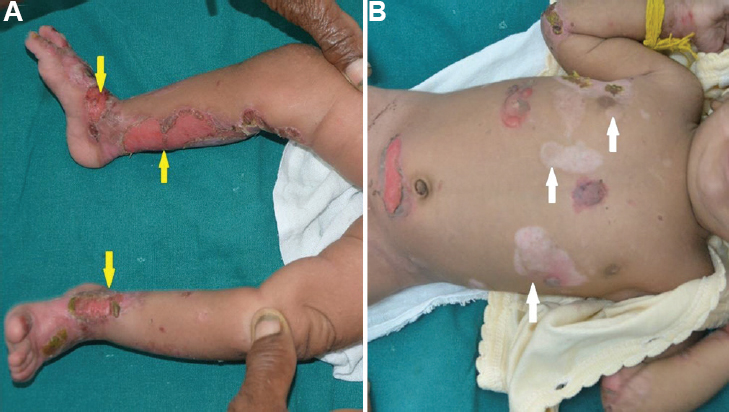Translate this page into:
A case report of dystrophic epidermolysis bullosa: Butterfly baby
*For correspondence: hima36@gmail.com
-
Received: ,
This is an open access journal, and articles are distributed under the terms of the Creative Commons Attribution-NonCommercial-ShareAlike 4.0 License, which allows others to remix, tweak, and build upon the work non-commercially, as long as appropriate credit is given and the new creations are licensed under the identical terms.
This article was originally published by Wolters Kluwer - Medknow and was migrated to Scientific Scholar after the change of Publisher.
A 37 day old female child† presented to the Dermatology outpatient department of Sri Manakula Vinayagar Medical College and Hospital, Puducherry, India, in September 2018, with complaints of peeling of skin and multiple erosions at sites of friction or trauma. The child was the first born in a first-degree consanguineous marriage. On examination, there were multiple erosions with crusts over the trunk, legs, ankle and dorsum of feet (Fig. 1A) and a few post-inflammatory hypopigmented macules over the trunk (Fig. 1B). There were no mucosal lesions, nail involvement or milia. Histopathological examination revealed a normal epidermis with subepidermal bulla. Antigen mapping with antibody probes revealed staining with Type IV collagen, laminin 332, bullous pemphigoid antigen 180 on the epidermal side of the split and complete absence of staining of Type VII collagen, suggestive of the dystrophic type of epidermolysis bullosa. The erosions were cleaned with saline and covered with mupirocin ointment and paraffin gauze dressings. The parents were taught regarding gentle handling of the child and use of soft inside-out clothing to reduce friction. The erosions reduced in size in a week. Follow up after one year showed a few small erosions, loss of a few nails and multiple hypopigmented macules and atrophic scars (Fig. 2).

- (A) Multiple erosions (yellow arrows) with crusts over the legs, ankle and dorsum of feet. (B) A few post-inflammatory hypopigmented macules (white arrows) over the trunk.

- Multiple hypopigmented macules and atrophic scars (yellow arrows), and loss of nails (blue arrow).
An accurate diagnosis of the subtype of epidermolysis bullosa is essential to provide prognostic information and genetic counselling. At present, there is no cure for epidermolysis bullosa, and thus protection from trauma and ensuring optimal wound healing form the mainstay of management.
Acknowledgment:
Authors acknowledge Dr Arulkumaran Arunagirinanthan, department of Pediatrics, Sri Manakula Vinayagar College and Hospital, Puducherry, for his guidance and support in the management of this case.





